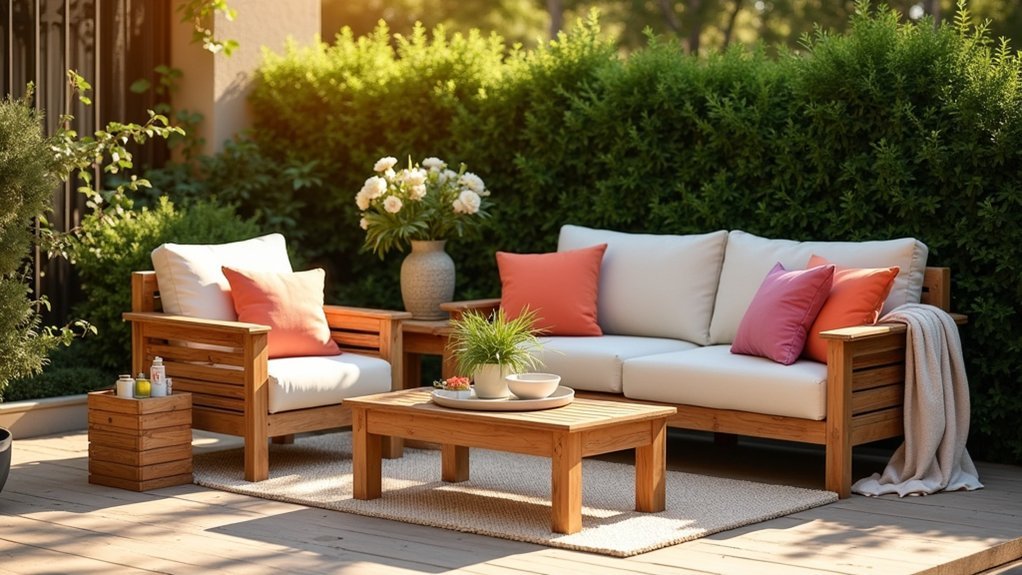You’ll keep your teak patio furniture looking stunning by establishing a monthly cleaning routine with mild soap and warm water, cleaning spills immediately to prevent staining, and lifting pieces properly when moving them. Apply quality teak sealers with UV protection annually, position furniture away from high-moisture areas, implement mildew prevention strategies, and store pieces indoors during winter months. These essential practices will protect your investment and maintain the wood’s natural beauty for decades to come.
Establish a Regular Cleaning Schedule for Your Teak Furniture

While teak’s natural durability makes it an excellent choice for outdoor furniture, establishing a consistent cleaning routine will greatly extend its lifespan and preserve its appearance.
Regular maintenance of teak furniture significantly enhances longevity while maintaining its distinctive natural aesthetic appeal for years.
You’ll want to establish a cleaning routine that includes scrubbing with a stiff bristle brush at least four times monthly to prevent dirt and bird droppings from accumulating. For thorough cleaning, use diluted dish soap and warm water, then guarantee complete drying to avoid mildew growth.
When stains occur, address them immediately by scrubbing along the wood grain.
Don’t forget to schedule an annual deep clean using a specialized teak cleaner to remove heavy stains and restore your furniture’s natural beauty.
Clean Up Spills Immediately to Prevent Staining
When spills happen on your teak furniture, you’ll want to clean them up immediately to prevent permanent staining.
The longer liquids sit on the wood surface, the deeper they’ll penetrate and the harder they’ll become to remove.
Quick action combined with the right cleaning technique will keep your teak looking pristine for years to come.
Act Fast Against Stains
Since teak’s natural oils provide some protection against moisture, they can’t prevent all staining if spills sit too long on the surface. To act fast against stains, immediate cleanup is your best defense against permanent discoloration.
When stains occur, use a stiff bristle brush or plastic scrubber, always working with the wood grain direction. For stubborn stains that won’t budge with basic cleaning, apply a diluted wood cleaner and allow it to work before scrubbing again. If necessary, fine-grit sandpaper can help remove deeper stains.
Essential stain-fighting strategies:
- Keep a dedicated cleaning kit with proper tools readily accessible
- Clean spills within minutes to prevent penetration
- Always scrub following the wood grain pattern
- Use plastic scrapers, never metal brushes or steel wool
- Implement regular maintenance schedules to prevent buildup
Proper Spill Cleaning Technique
Speed matters most when spills hit your teak furniture. The proper spill cleaning technique starts with immediate action to prevent permanent staining.
Clean spills right away using a soft cloth to blot the area gently. For basic cleaning, mix water with mild soap and apply it to the affected spot. Always scrub in the direction of the wood grain using a stiff bristle brush or plastic scraper to avoid surface damage.
When dealing with stubborn stains, prepare a dilute mixture of water and mild wood cleaner, then scrub gently with your soft cloth. For heavy stains, fine-grit sandpaper works effectively.
Make certain your furniture is thoroughly dried afterward to prevent mold and mildew growth.
Use Proper Lifting Techniques When Moving Teak Pieces

Although teak furniture is durable, you’ll want to handle it carefully during moves to preserve its natural beauty and structural integrity. When you use proper lifting techniques, you’ll protect your investment and guarantee longevity.
Always lift teak furniture rather than dragging it to avoid friction damage that can scratch surfaces.
- Assess the furniture’s assembly beforehand and identify strong points for a secure grip
- Clear your path completely of obstacles to prevent accidents and collisions
- Get help with larger or heavier teak pieces to distribute weight properly
- Plan your placement strategy to minimize risk of injury from unnecessary lifting
- Focus on safe and efficient movement by coordinating with helpers before starting
Apply Quality Teak Sealers for UV Protection
You’ll want to select a golden teak sealer that contains UV protectants to preserve your furniture’s natural honey-brown color and prevent it from turning gray.
Apply two initial coats when you first treat the wood, ensuring complete coverage across all surfaces.
Set up an annual recoating schedule to maintain ideal protection and keep your teak looking its best year after year.
Choose Golden Sealer
When preserving your teak furniture’s natural golden color becomes a priority, Golden Sealer offers an exceptional solution that combines UV protection with color retention.
This water-based sealer prevents the natural weathering process that turns teak gray while providing essential protection against sun damage. Proper teak care with quality teak sealers like Golden Sealer will extend the life of your outdoor furniture considerably.
- Requires initial two-coat application with annual recoating for ideal protection
- Eco-friendly formula that’s safe for surrounding plants and animals
- Prevents mold and mildew growth while maintaining furniture appearance
- Features indefinite shelf life for future touch-ups without waste
- Water-based composition makes it environmentally responsible for outdoor use
This sealer transforms routine maintenance into effective long-term furniture preservation.
Annual Recoating Schedule
Establishing a consistent annual recoating schedule forms the foundation of effective teak furniture care and guarantees your investment remains protected year after year. You’ll need to clean your teak furniture thoroughly before each application, removing dirt and old treatments that prevent proper adhesion. Apply your water-based teak sealer in two coats during initial treatment, then maintain with annual recoating thereafter.
| Month | Task | Product |
|---|---|---|
| March | Clean and prep surface | Teak cleaner |
| April | Apply teak sealer (2 coats initially) | Water-based teak sealer with UV protectants |
| Monthly | Inspect for wear | Teak oils for touch-ups |
This schedule prevents moisture damage while preserving your furniture’s golden-brown appearance against UV rays and weathering.
Position Furniture Away From High Moisture Areas

Since teak furniture performs best in dry conditions, you’ll want to strategically position your pieces away from areas where moisture tends to accumulate.
Outdoor furniture placement greatly impacts longevity, so avoid spots under overhanging trees or shaded corners where water lingers. Proper air circulation prevents moisture retention and allows natural drying after rain or cleaning.
Strategic positioning protects your teak furniture from high humidity damage:
- Position pieces away from sprinkler systems and poolside areas
- Guarantee adequate spacing between furniture for ideal air circulation
- Avoid placing under tree canopies where moisture accumulates
- Choose elevated locations that promote drainage
- Use breathable furniture covers in unavoidable high humidity areas
Regular inspection during seasonal changes helps you relocate pieces when necessary, preventing water damage and maintaining your teak’s natural beauty for years.
Implement Mildew Prevention Strategies
While proper positioning forms your first line of defense, implementing targeted mildew prevention strategies guarantees your teak furniture stays pristine and healthy.
You’ll want to establish a consistent teak cleaning routine, washing your outdoor teak furniture at least annually with mild soap and a soft plastic bristle brush to remove dirt and pollen buildup.
Always eliminate standing moisture immediately after rain or cleaning sessions, as trapped water accelerates mildew formation.
Consider applying specialized care products like teak mildew shields that inhibit mold growth while preserving the wood’s natural oils and breathing properties.
Store furniture indoors during winter months or use breathable covers to prevent dampness exposure.
Regular inspections help you catch and remove any mildew signs before they spread.
Store Teak Furniture Indoors During Winter Months

Although teak’s natural durability makes it weather-resistant, you’ll extend your furniture’s lifespan considerably by bringing it indoors when temperatures drop.
Protecting teak furniture indoors during cold weather significantly increases its longevity despite the wood’s inherent resistance to outdoor elements.
When you store teak furniture indoors during winter months, you’ll protect it from high moisture levels that can prevent deterioration and mildew growth.
- Ascertain all surfaces are completely dry before storing to avoid trapping moisture
- Use breathable furniture covers to prevent dust accumulation while allowing air circulation
- Choose a climate-controlled environment to maintain the wood’s natural oils
- Check stored furniture regularly for moisture buildup or mildew signs
- Perform timely cleaning and maintenance when issues arise
A climate-controlled space prevents warping and cracking while preserving your teak’s integrity throughout harsh winter conditions.
Frequently Asked Questions
How Do You Maintain Outdoor Teak Furniture?
Clean your teak furniture monthly with diluted soap and stiff brush, following wood grain. Apply annual sealer protection, immediately clean spills, store indoors during winter, and regularly check for mildew growth.
What Is the Best Treatment for Outdoor Teak Furniture?
You’ll want to use a quality teak sealer that retains the wood’s natural color, protects against UV damage, and prevents mildew growth while preserving the wood’s natural oils effectively.
Is It Better to Oil or Seal Teak?
You should seal teak rather than oil it. Sealing prevents mildew growth, offers UV protection, and maintains the wood’s natural color while requiring less frequent reapplication than oiling.
Should Outdoor Teak Be Oiled?
You shouldn’t oil outdoor teak furniture. Teak’s natural oils provide sufficient protection, and adding more oil can cause mildew growth and require unnecessary maintenance. Use sealers instead to preserve color and prevent UV damage.





Leave a Reply